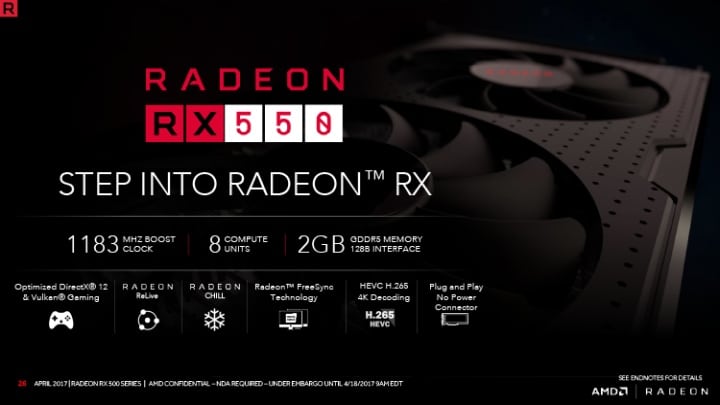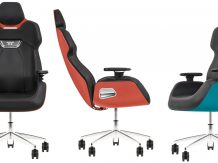RX 550 4gb vs GT 1030 Game Debate: Hashrate(Which is Better)| Power (WATT) Usage – Review and testing of Radeon RX 550. Comparison with GeForce GT 1030 and old generation video cards
Everyone is watching the development of the industry in the segment of top-end graphics solutions, where the confrontation between AMD and NVIDIA is most fierce. However, the cheapest video cards are in demand. Someone needs a replacement for a failed adapter in an elderly PC, someone a temporary “plug” with the ability to play popular online games. Therefore, we scrupulously study the gaming capabilities of the entire range of available devices. We recently tested the ultra-budget card GeForce GT 1030. Now let’s get acquainted with the new product from the red camp – AMD Radeon RX 550. Let’s test the ASUS graphics card, check its overclocking capabilities, compare it with the GeForce GT 1030 and a number of old video cards.
Radeon RX 550 fully belongs to the new generation of graphics cards, although it has modest characteristics. At the heart of this model is the Polaris processor family with all the advantages of this architecture. Therefore, the Radeon RX 550 is the most significant update for AMD ultra-budget graphics cards in the past few years.
At the heart of the novelty is the Polaris 12 processor with eight computing units CU. The total potential of this chip is 512 processing cores, 32 texture units and 16 rendering units. This configuration is twice weaker than the characteristics of the Radeon RX 560, that is, the gap between these budget video cards should be quite large. But this situation is typical for NVIDIA as well. The Polaris 12 is manufactured using an advanced 14nm manufacturing process that delivers a low TDP of 50W. Operating frequencies of the core are declared from 1100 MHz (base value) to 1183 MHz (maximum Boost). Acquaintance with the Radeon RX 560 showed that there are video cards with different frequencies in the stated range, but this was due to the presence of economical versions. Since the Radeon RX 550 initially consumes little and does not require additional power, it can be assumed that
An important advantage of the Radeon RX 550 is a full 128-bit bus and fast GDDR5 memory with an effective frequency of 7000 MHz. This is a significant plus against the background of the GeForce GT 1030 with a 64-bit bus.
According to the number, the Radeon RX 550 will replace the video adapter Radeon R7 350. The latter was another variation based on the Cape Verde core, and was an updated version of the Radeon HD 7750. This is an old-timer, which is not enough. Although the entire Radeon R7 350 series is a little strange – there were modifications for 640 stream processors and OEM variations on the Oland chip with 384 stream processors (analogous to the Radeon R7 250). Also, some manufacturers equipped the Radeon R7 350 with slow DDR3 memory, which drastically reduced the overall computing capacity. Now DDR3 memory has disappeared from the video card market, and there will be no unpleasant surprises with the Radeon RX 550. Within the framework of the new series, different models can only be allocated with higher frequencies of cores and an expanded amount of memory instead of the standard 2 GB.
Comparison: Radeon RX 550 vs Radeon RX 560 vs Radeon R7 360 vs Radeon R7 350
let’s summarize the characteristics of the Radeon RX 550 and the nearest video cards in one table.
| Video adapter | Radeon RX 560 | Radeon RX 550 | Radeon R7 360 | Radeon R7 350 |
|---|---|---|---|---|
| Core | Polaris 11 | Polaris 12 | Tobago | Cape Verde |
| Architecture | GCN 1.3 | GCN 1.3 | GCN 1.1 | GCN 1.0 |
| Number of transistors, mln.pcs | 3000 | 2200 | 2080 | 1500 |
| Process technology, nm | 14 | 14 | 28 | 28 |
| Core area, sq. mm | 123 | 101 | 160 | 123 |
| Number of stream processors | 1024 | 512 | 768 | 640/512 |
| Number of texture units | 64 | 32 | 48 | 40/32 |
| Number of rendering units | 16 | 16 | 16 | 8 |
| Core frequency, MHz | 1175–1275 | 1100–1183 | Until 1050 | 925+ |
| Memory bus, bit | 128 | 128 | 128 | 128 |
| Memory type | GDDR5 | GDDR5 | GDDR5 | GDDR5 / DDR3 |
| Memory frequency, MHz | 7000 | 7000 | 6500 | |
| Memory size, MB | 4096/2048 | 4096/2048 | 2048 | 2048/1024 |
| Supported DirectX Version | 12 | 12 | 11 | 11 |
| Interface | PCI-E 3.0 | PCI-E 3.0 | PCI-E 3.0 | PCI-E 3.0 |
| Power, W | 75 | 50 | 100 | 75 |
The Radeon RX 550 can output HDR content and is equipped with DVI, HDMI 2.0b and DisplayPort 1.3 / 1.4 HDR Ready ports.
A video adapter made by ASUS with standard frequencies, but memory capacity increased to 4 GB, will take part in our testing. More details below.
ASUS Radeon RX 550 4G (RX550-4G)
At the moment, ASUS is releasing two versions of the Radeon RX 550, which are identical in technical performance, but differ in memory size. We are going to take a look at the ASUS RX550-4G with 4GB on board.
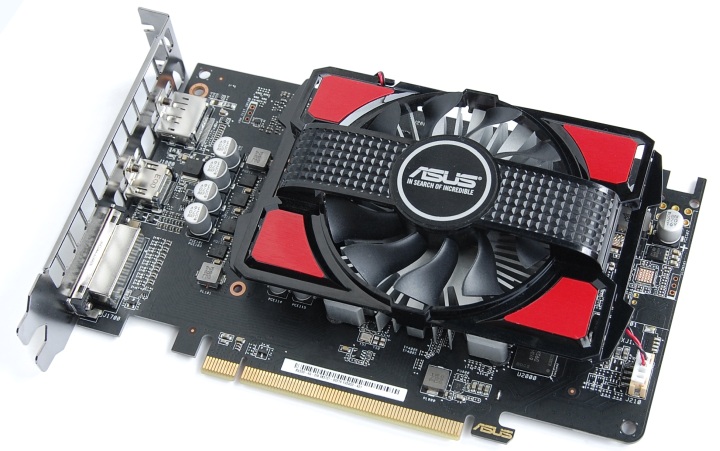
The video adapter is made on a full-profile format board and occupies two expansion slots due to the cooling system. The black color of the PCB and the casing is combined with the large red inserts on the casing. The fan is partially covered by a decorative strip, and this clearly interferes with the air flow
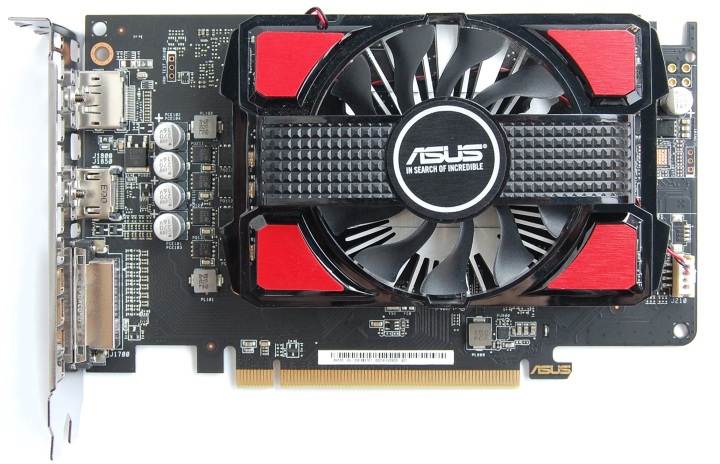
ASUS dispenses with an additional power connector. When examining the reverse side, you can notice the presence of a warranty seal on one of the screws of the cooling system.
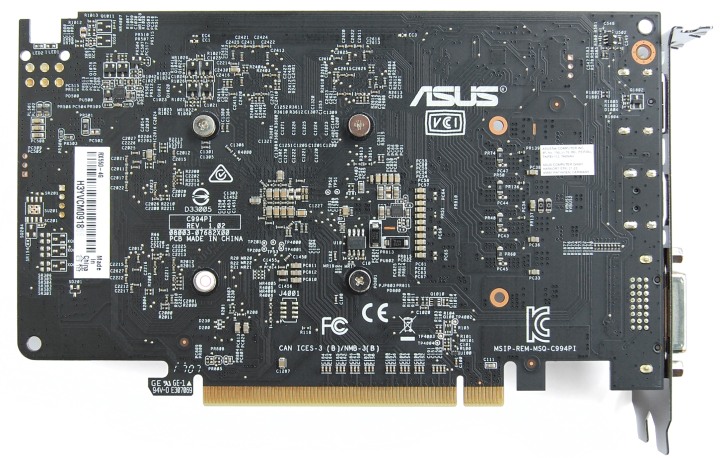
The RX550-4G has three video output ports: DVI, HDMI and DisplayPort.
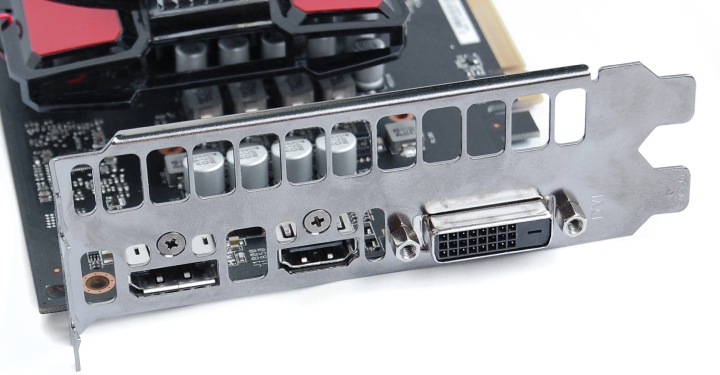
Cooler of simple design. Under the casing is a one-piece aluminum radiator with diverging fins.
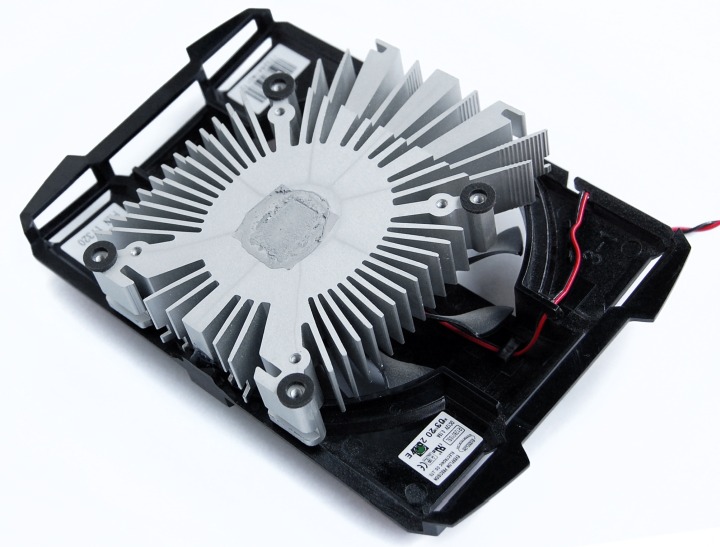
This design is very similar to the cooler on old budget-class ASUS cards. A complete parsing was not carried out. It looks like glue is being used and removing the shroud would damage the appearance of the device.
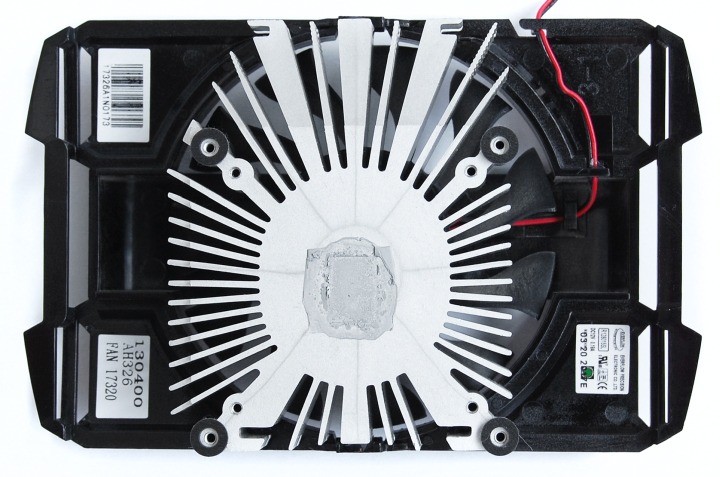
The board looks pretty serious for such a budget card. Implemented a four-phase GPU power system. The GeForce GT 1030 is content with one or two phase power supplies.
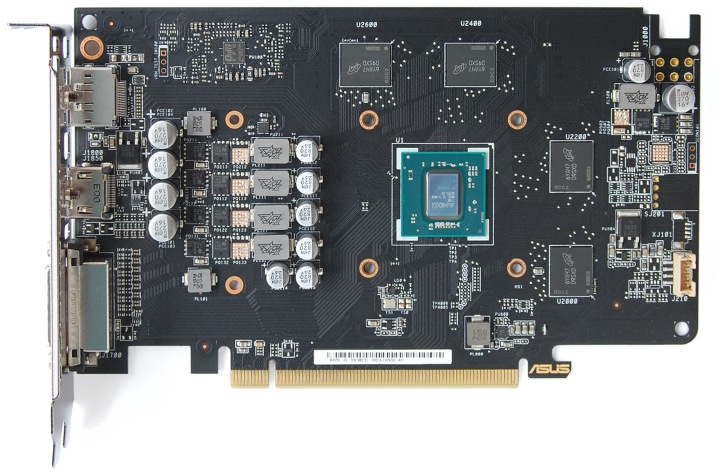
The Polaris 12 graphics chip is on a substrate without a protective frame. Four gigabytes of memory are collected by four Micron 6YA47 D9SXD microcircuits.
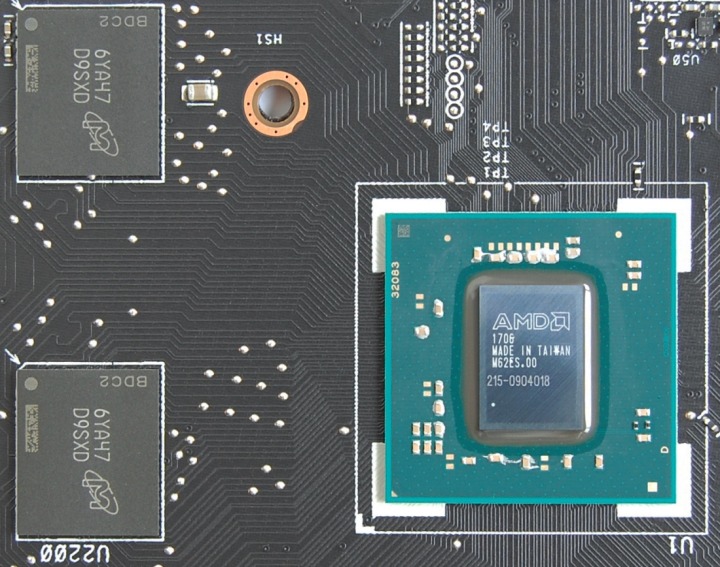
The video card operates strictly at the recommended frequencies: the core frequency is 1183 MHz, the memory clock is 1750 MHz (effective 7000 MHz).
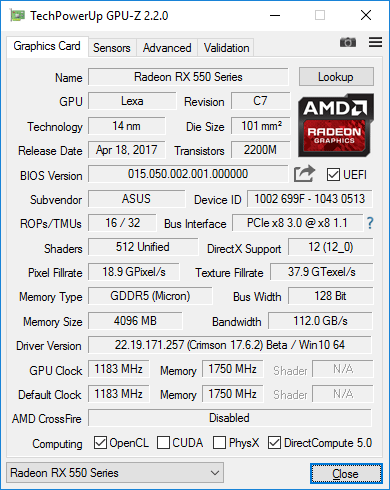
Judging by the GPU-Z data, the video card works with an 8x PCI-E 3.0 interface. This is not surprising, the Radeon RX 560 works in the same mode.
When tested on an open bench at about 25 ° C, the peak core temperatures were 59-60 ° C. The declared frequency of 1183 MHz was maintained at a stable level in absolutely all applications under any load.
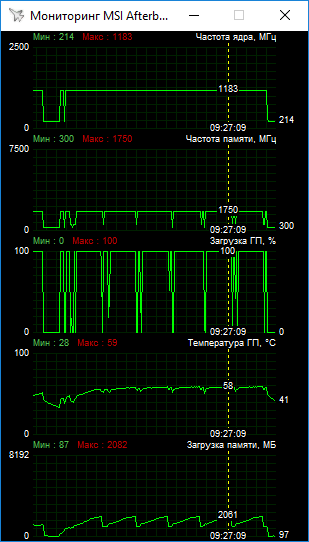
With a little heating, you can count on a low noise level. However, in reality there is some hum. When working inside the case, this is a less significant problem, but against the background of quiet ASUS components you will hear it. And the speed is not regulated in any way, the fan runs at the same speed in idle and under load.
It is worth recalling that cooling the Radeon RX 560 is not a trivial task. At a low TDP, small chips remain quite hot. And the more powerful Polaris are famous for their hot temper. It looks like the Polaris 12 is not much better, and ASUS is addressing the cooling issue at the expense of high revs.
The situation with overclocking made us happy. From an initial frequency of 1183 MHz, the graphics processor was overclocked to 1405 MHz. The memory was stable at 8000 MHz. Higher values could have been set, but stability dropped sharply.
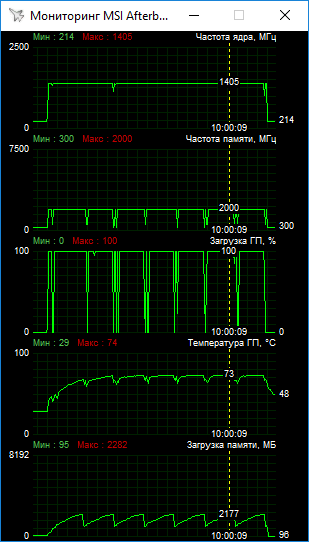
At a fixed blower fan speed, the heating increased to 74 ° C. This is not a critical value, so overclocking can be used for everyday tasks.
Characteristics of the tested video cards
Let’s compare the performance of the reviewed video card with a group of models of different generations. The complete list of participants is as follows:
- Radeon R7 260;
- Radeon RX 550;
- GeForce GTX 750 Ti;
- GeForce GTX 750;
- GeForce GT 1030.
The most powerful solution on this list is the GeForce GTX 750 Ti, and this card has only been tested in its nominal value. The rest of the participants were tested at standard frequencies and overclocked. ASUS PH-GT1030-O2G acts as a GeForce GT 1030 with a slight decrease in frequencies to the standard level.
Detailed technical characteristics of the video cards are given below. The table shows the official Boost frequencies for GeForce, the performance graphs show the full frequency range, including short-term peaks.
| Video adapter | Radeon RX 550 | Radeon R7 260 | GeForce GTX 750 Ti | GeForce GTX 750 | GeForce GT 1030 |
|---|---|---|---|---|---|
| Core | Polaris 12 | Bonaire | GM107 | GM107 | GP108 |
| Number of transistors, mln.pcs | 2200 | 2080 | 1870 | 1870 | – |
| Process technology, nm | 14 | 28 | 28 | 28 | 14 |
| Core area, sq. mm | 101 | 160 | 148 | 148 | 71 |
| Number of stream processors | 512 | 768 | 640 | 512 | 384 |
| Number of texture units | 32 | 48 | 40 | 32 | 24 |
| Number of rendering units | 16 | 16 | 16 | 16 | 16 |
| Core frequency, MHz | 1183 | 1000 | 1020–1085 | 1020–1085 | 1227–1468 |
| Memory bus, bit | 128 | 128 | 128 | 128 | 64 |
| Memory type | GDDR5 | GDDR5 | GDDR5 | GDDR5 | GDDR5 |
| Memory frequency, MHz | 7000 | 6000 | 5400 | 5010 | 6000 |
| Memory size, MB | 4096 | 1024 | 2048 | 1024 | 2048 |
| Supported DirectX Version | 12 | 12 | 12 | 12 | 12 |
| Interface | PCI-E 3.0 (8x) | PCI-E 3.0 | PCI-E 3.0 | PCI-E 3.0 | PCI-E 3.0 (4x) |
| Power, W | 50 | 95 | 60 | 55 | 30 |
Test stand
The test bench configuration is as follows:
- processor: Intel Core i7-6950X (3.0 @ 4.1 GHz);
- cooler: Noctua NH-D15 (two NF-A15 PWM fans, 140 mm, 1300 rpm);
- motherboard: MSI X99S MPower (Intel X99);
- memory: G.Skill F4-3200C14Q-32GTZ (4×8 GB, DDR4-3200, CL14-14-14-35);
- system drive: Intel SSD 520 Series 240GB (240 GB, SATA 6Gb / s);
- additional disk: Hitachi HDS721010CLA332 (1 TB, SATA 3Gb / s, 7200 rpm);
- power supply unit: Seasonic SS-750KM (750 W);
- monitor: ASUS PB278Q (2560×1440, 27 ″);
- operating system: Windows 10 Pro x64;
- GeForce driver: NVIDIA GeForce 382.53.
- Radeon driver: AMD Crimson Edition 17.6.2.
Testing was carried out at a resolution of 1920×1080 using the method described below. The games are listed alphabetically. At the end of the list are tank games and 3DMark results.
Testing technique
Battlefield 4
Testing was carried out in the first mission after blowing up the wall. Jogging over a small area with dense vegetation was repeated before descending to a large construction site. Frame rates were measured using Fraps.
Graphics settings are High, Antialiasing Post is Medium, and MSAA is completely disabled.
Battlefield 1
Instead of the usual scene in the mission “Cape Helles” with an extreme load, a test scene was used at the beginning of the mission “With all his might”, where the hero participates in an attack on enemy positions, driving a tank.
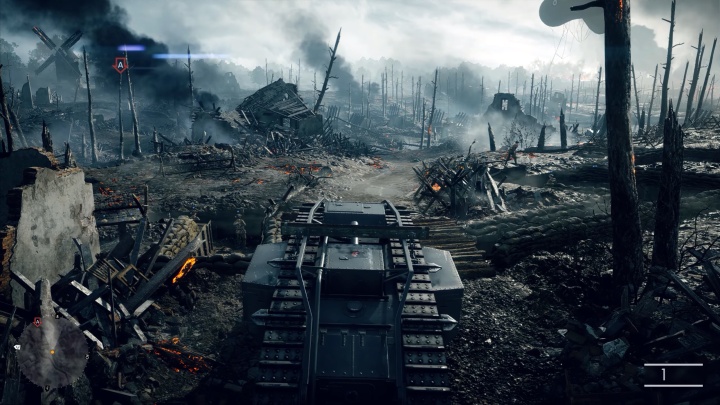
The selected graphics quality is medium. Tested in DirectX 11 using Fraps.
DIRT 4
Testing was conducted during a replay of the first race in the Dirt Fish Championship (Liske Forest Track, Michigan). Five repetitions were performed for a more accurate average result.
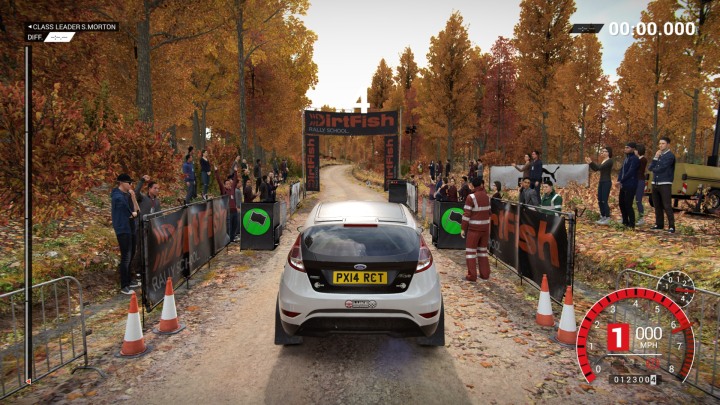
High quality graphics profile selected. All anti-aliasing options are disabled, anisotropic filtering in 16x mode.
Dota 2
A recording of one of the tournament games was played; a test segment of 70 seconds was selected. Several repetitions to reduce the error. The maximum quality of graphics is set, in manual mode the maximum quality of shadows is additionally activated. Our settings configuration is reflected below.
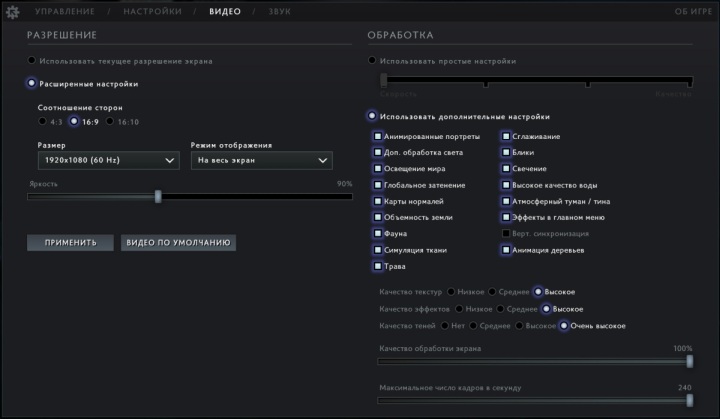
The game was launched in DirectX 11 rendering mode by specifying the appropriate attribute in the launch parameters. Empirically revealed that this is the most productive mode. Vulkan was not used due to the lack of normal monitoring tools under this API.
Fallout 4
Testing was done with Fraps right after leaving the hideout at the start of the game. We took a short walk through the surroundings with an abundance of vegetation and rich rays of light. Scenes with this environment will cause the most noticeable performance degradations. The procedure is shown below.
The selected profile is of medium quality graphics. The simpler FXAA is chosen instead of TAA.
Gears of War 4
The built-in gaming benchmark was used, which was run seven times.
Medium graphics quality selected, additional DirectX 12 features are active (Async Compute, etc.).
Grand Theft Auto 5
The built-in benchmark was used for testing. Five repetitions. For a comprehensive assessment, the average fps was calculated based on the results of all test scenes. The minimum fps was measured using Fraps based on the results of a full pass of the backmark.
All graphics settings are limited to “very high”, shadows are “softer”. For most parameters, this is the maximum value, for some it is one level below the maximum. Simple anti-aliasing FXAA selected. Additional settings are not involved.
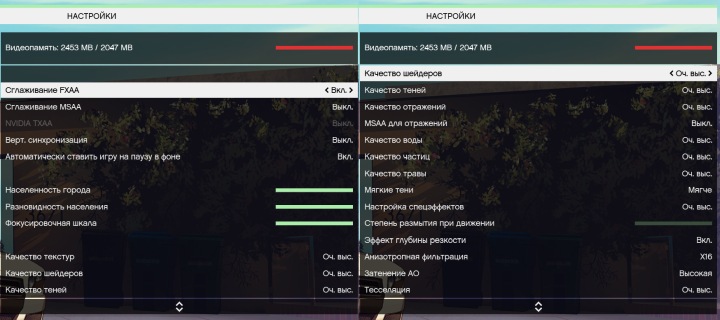
Mass Effect: Andromeda
A short run was made during the very first landing on the planet. Frame rates were measured by Fraps.
Selected presets of medium quality without any additional edits. In this mode, the game activates scaling at a lower initial render resolution (900p upscaled to Full HD).
Prey (2017)
Performance was measured by Fraps when replaying a specific sequence of actions within the initial game stage, when the hero must break glass.
Selected a profile of medium quality graphics, additionally increased the quality of anisotropic filtering to 8x.
The Elder Scrolls V: Skyrim Special Edition
A walk was performed along a certain route near the road that runs from the caves, from which the hero at the beginning of the game escapes from the Helgen fortress. This route is notable for the rich vegetation around and the pronounced effect of sunlight at the selected time.
The selected graphics quality is medium, the quality of the light rays is additionally lowered to a low level.
The Witcher 3: Wild Hunt
Testing was done using Fraps. Fps was measured during a trip to the village of Bely Sad. Five repetitions.
In the section of the main settings, the average quality is set for all parameters. In the post-processing section, all effects are turned off.
Tom Clancy’s The Division
The built-in benchmark was run at least seven times for each mode.
Selected low quality profile in DirectX 11. Additionally, the settings related to general shadows (shadow quality, shadow resolution) have been increased by one step. It’s worth noting that in Low mode, the game sets the scaling at 85% of the selected resolution, so the actual resolution is less than Full HD.
Torment: Tides of Numenera
Testing was carried out at the beginning of the game, when the hero enters the first open location. The frame rate was measured for 15 seconds, three starts. Cameras as far away as possible to cover as much space as possible.
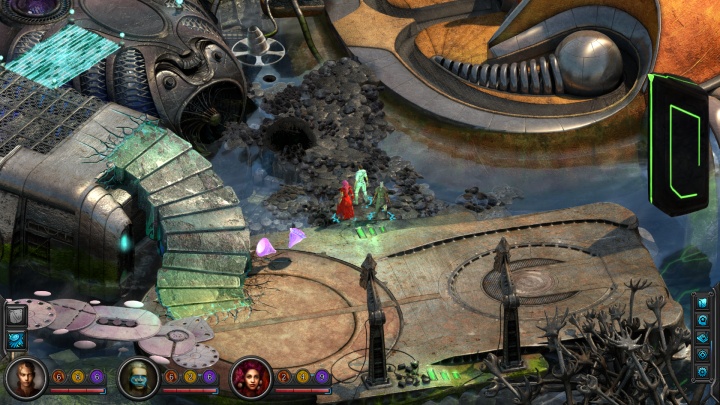
There are practically no graphics settings in the game. Selected resolution, high quality anti-aliasing and dynamic display of clothes.
Warhammer 40000: Dawn of War III
The built-in benchmark was used. For control, the Fraps utility is additionally involved.
The minimum graphics quality is selected at a fixed resolution of 1920×1080, the physics is minimal, anti-aliasing is disabled.
Watch Dogs 2
In this case, a walk was performed in the Palo Alto area, jogging through the streets and a nearby grove of trees and dense grass.
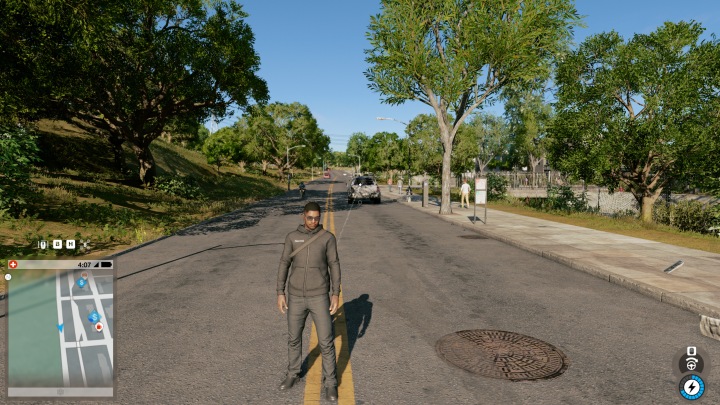
The selected profile is of medium quality graphics. Additionally, the “Temporary filtering” option is included, which allows you to increase performance with a negligible loss in quality.
War Thunder
The game performance benchmark “Tank Battle” was run seven times. The quality profile “Cinema” is selected.
World of Tanks
For testing, among the replays posted in the public domain, a recording of the battle on a large detailed map of the “Fjords” was selected, a 70-second test segment was selected. Four repetitions, frame rate measured by Fraps.
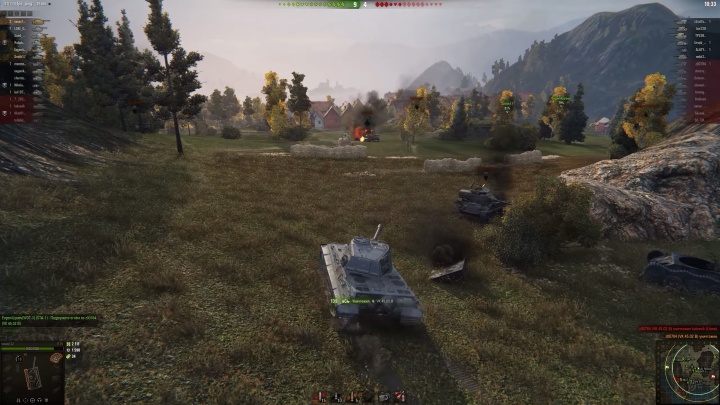
Selected profile of maximum quality without additional edits of parameters, anti-aliasing FXAA.
3DMark Fire Strike
Fire Strike benchmark from the latest 3DMark benchmark suite, tested in idle mode at 1920×1080.
3DMark Time Spy
New benchmark for DirectX 12, launched with default settings.
Energy consumption
The results are given as a result of measurements in six appendices:
- Dota 2;
- Grand Theft Auto 5;
- Tom Clancy’s The Division;
- Warhammer 40000: Dawn of War III;
- War Thunder;
- World of Tanks.
The peak values during each run were taken into account, from which the average consumption for each application was calculated, and then the overall average was calculated. The data were taken using a Cost Control 3000 instrument.
Test results
Battlefield 4

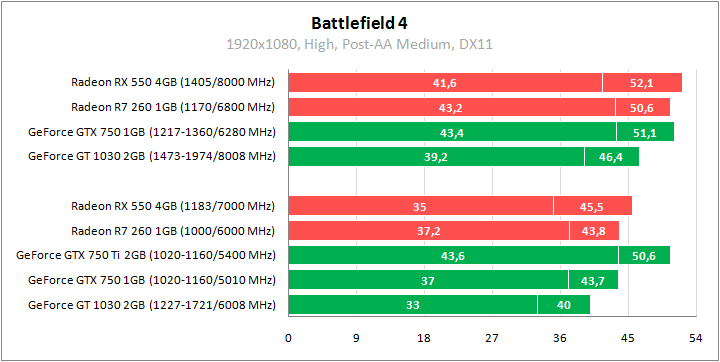
Similar results for the Radeon RX 550 and Radeon R7 260 in Battlefield 4 in par and in overclocking. At the same level, the performance of the GeForce GTX 750, and the GeForce GT 1030 is weaker than the Radeon RX 550 by 6-14%. Increasing the clock speeds up the Radeon RX 550 by 15-19% to keep up with the GeForce GTX 750 Ti.
Battlefield 1
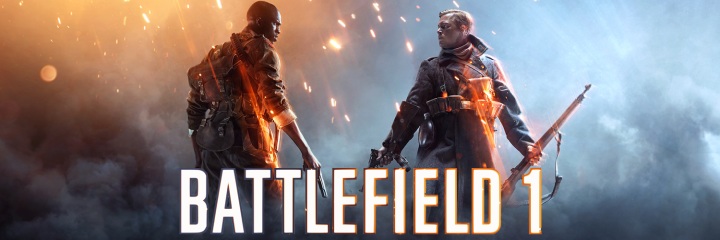
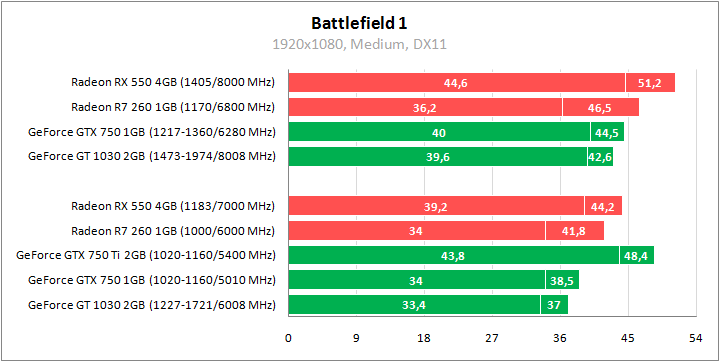
In the new Battlefield 1, the Radeon RX 550 has a serious advantage over the Radeon R7 260 and GeForce GTX 750. This may be directly related to the large amount of memory, since the game is sensitive to this factor. With the selected settings, the memory load reached 2 GB. The lag of the Radeon RX 550 from the GeForce GTX 750 Ti is about 11%, which is easily covered by overclocking. The video adapter GeForce GT 1030 is almost as good as the GeForce GTX 750, and in overclocking it catches up with the Radeon RX 550 at standard frequencies.
DIRT 4

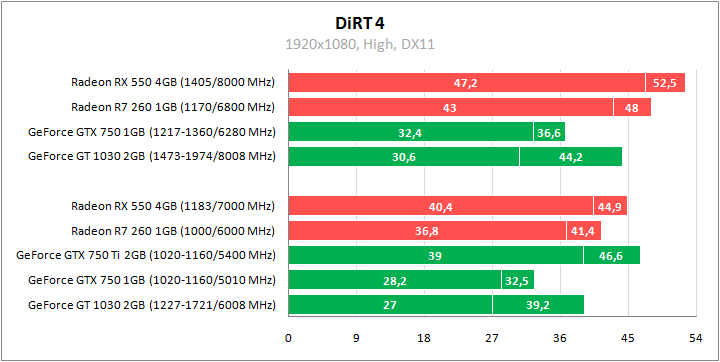
There is another game that is critical to the amount of video memory. In the test race, about 2.7 GB was involved, which seriously hit the results of the GeForce GTX 750 with 1 GB. The Radeon R7 260 feels better, despite the same volume. Our 4GB version of the Radeon RX 550 is almost as good as the GeForce GTX 750 Ti at the starting frequencies – impressive, but the memory limits the potential of NVIDIA’s rival. The 2GB GeForce GT 1030 offers better performance than the 1GB GeForce GTX 750.
Dota 2
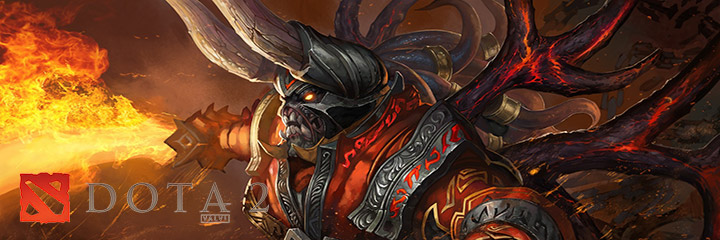
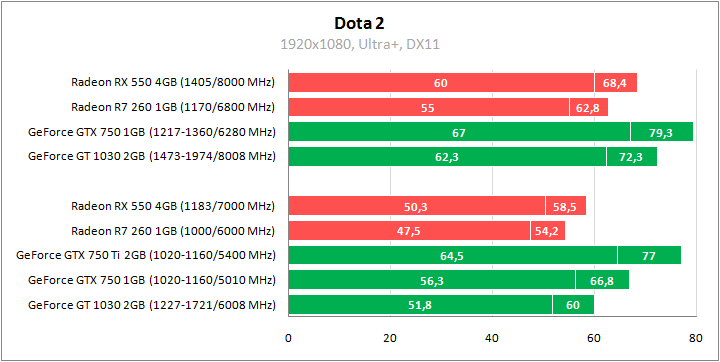
The Radeon RX 550 is 6-8% faster than the Radeon R7 260, but a couple of percent weaker than the GeForce GT 1030. The latter loses to the GeForce GTX 750. The overclocking gain of the Radeon RX 550 is 17-19%, the GeForce GT 1030 wins 20%. In overclocking, the Radeon RX 550 can compete with the GeForce GTX 750 in nominal value, and the GeForce GT 1030 is very close to the performance of the GeForce GTX 750 Ti.
Fallout 4

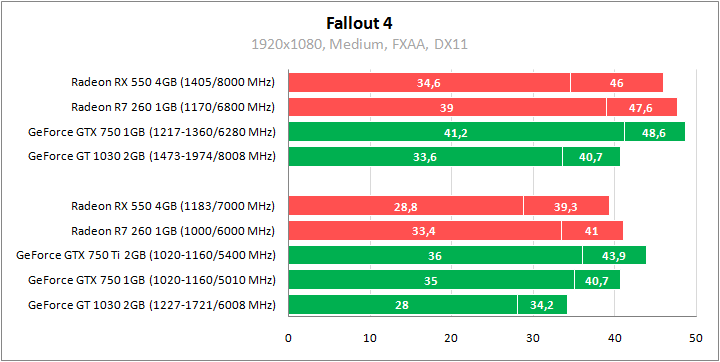
In Fallout 4, older video cards perform well, even with 1GB of video memory. However, there is a nuance that overrides their benefits. With 1 GB of memory, detailed textures are not loaded, that is, the picture is slightly worse, and the load on the GPU is lower. So a direct comparison is not correct here. This is clearly seen in the tiny difference between the GeForce GTX 750 and the GeForce GTX 750 Ti. But the comparison of Radeon RX 550 and GeForce GT 1030 with 2–4 GB of memory is already quite objective: there is an advantage of the new AMD product, but only in terms of the average frame rate. The overclocked video adapter GeForce GT 1030 is faster than the competitor with the initial frequencies.
Gears of War 4

The game requires at least 2 GB of video memory. At 1 GB, there are startup problems. And if it succeeded to boot, then the resolution is fixed at 1280×720. Therefore, I had to confine myself to the results of video adapters with 2-4 GB of video memory.
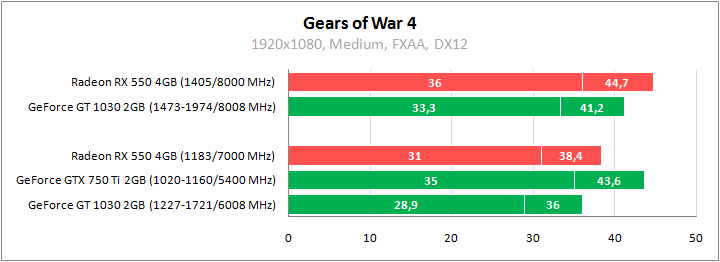
GeForce GTX 750 Ti leads in Gears of War 4. Radeon RX 550 outperforms GeForce GT 1030 by 7% in nominal value, with overclocking the difference between them is about 8%. The newcomer AMD also outperforms the GeForce GTX 750 Ti at maximum frequencies.
Grand Theft Auto 5

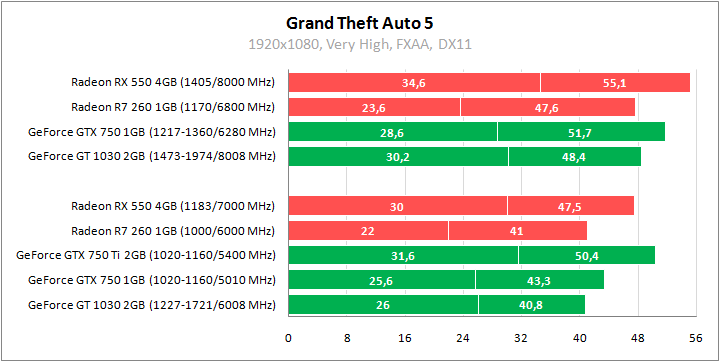
With the selected graphics settings, GTA 5 can load up to 3 GB of video memory or more. However, the younger GeForce copes well with such a load, overtaking the Radeon R7 260. The GeForce GTX 750 Ti is in the lead, and the Radeon RX 550 is only 6% weaker. Overclocking speeds up newcomer AMD by 16%. GeForce GT 1030 gains 16-18% with increasing frequencies, outperforming the Radeon RX 550 in the nominal value.
Mass Effect: Andromeda

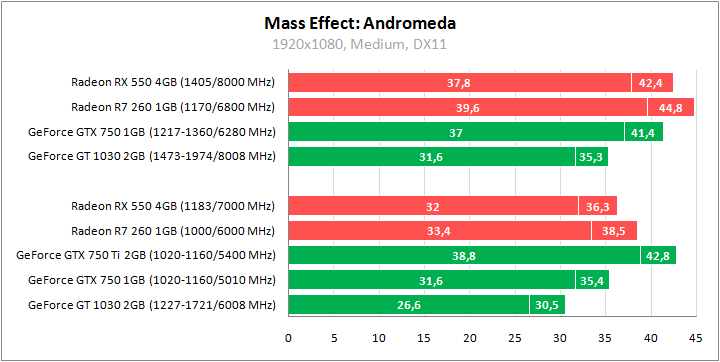
Unexpectedly, the Radeon R7 260 snatches victory over the Radeon RX 550 in Andromeda, albeit with a minimal advantage. The GeForce GTX 750 lags even more modestly behind the Radeon R7 260, but the GeForce GT 1030 loses to its rival AMD by up to 20%. By overclocking, the Radeon RX 550 can overtake the GeForce GTX 750 Ti. The forced accelerator GeForce GT 1030 is only approaching the Radeon RX 550 in nominal value.
Prey (2017)

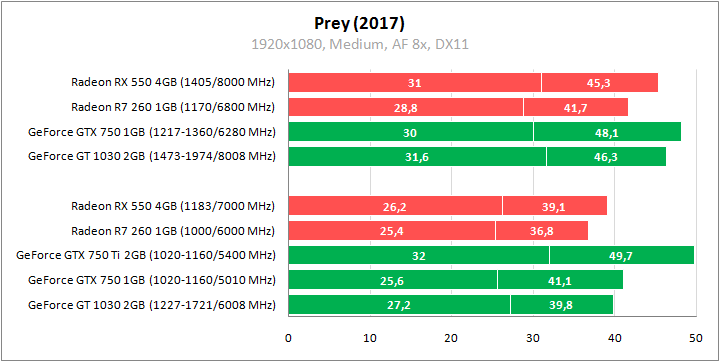
Radeon R7 260 has the worst results in Prey. The new Radeon RX 550 is 3-6% faster, but weaker than the GeForce GT 1030 and GeForce GTX 750 by 2-4%. This modest lag behind rivals is easily compensated for by raising the frequencies. In overclocking, the GeForce GT 1030 maintains a tiny edge over the Radeon RX 550.
The Elder Scrolls V: Skyrim Special Edition
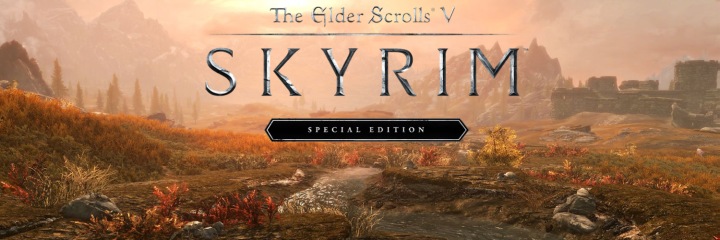
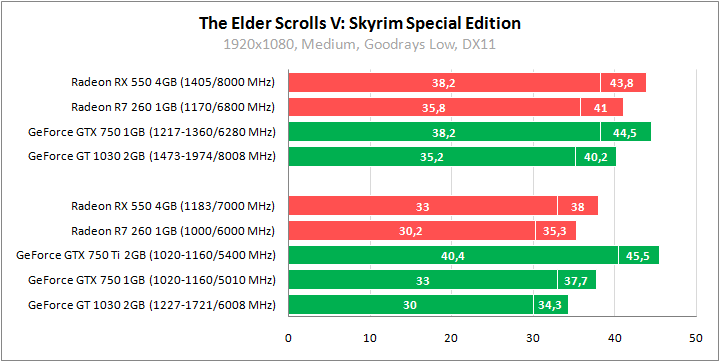
A re-release of the legendary Skyrim game could bring more powerful graphics cards to its knees. Therefore, even with average quality, the junior test participants deliver less than 40 fps. The Radeon RX 550 is 8-9% faster than the Radeon R7 260 and 10% better than the GeForce GT 1030. The newcomer is on par with the GeForce GTX 750 at the initial frequencies and in the nominal value, it fails to catch up with the GeForce GTX 750 Ti.
The Witcher 3: Wild Hunt

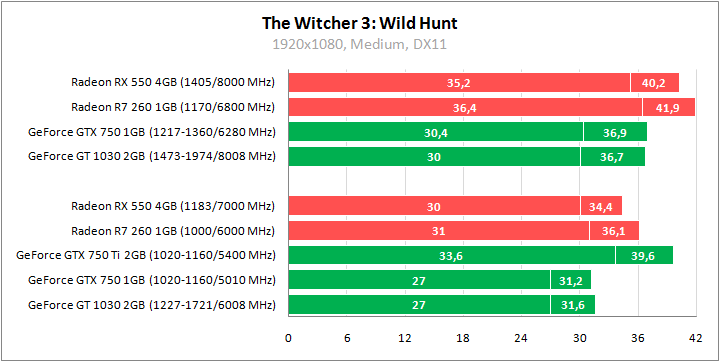
The Radeon RX 550 is midway between the GeForce GTX 750 and the GeForce GTX 750 Ti in The Witcher 3, just a few percent behind the Radeon R7 260. Overclocking allows it to outperform the GeForce GTX 750 Ti. The GeForce GT 1030 and GeForce GTX 750 have identical values in the nominal value and after overclocking.
Tom Clancy’s The Division

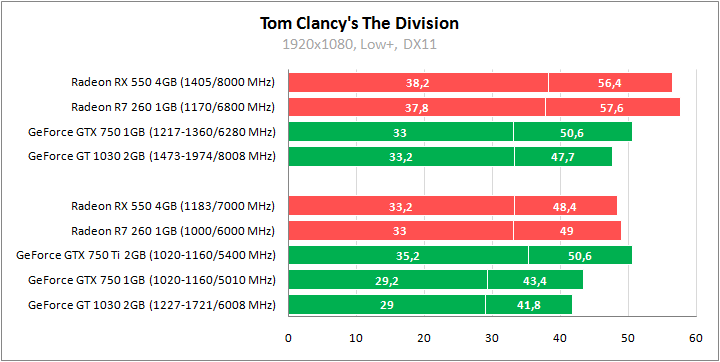
Newcomer to The Division has great results. The Radeon RX 550 is equal to the Radeon R7 260 and is inferior to the GeForce GTX 750 Ti by only 5%, showing a good lead over the GeForce GTX 750. The GeForce GT 1030 catches up with the Radeon RX 550 only at maximum frequencies.
Torment: Tides of Numenera

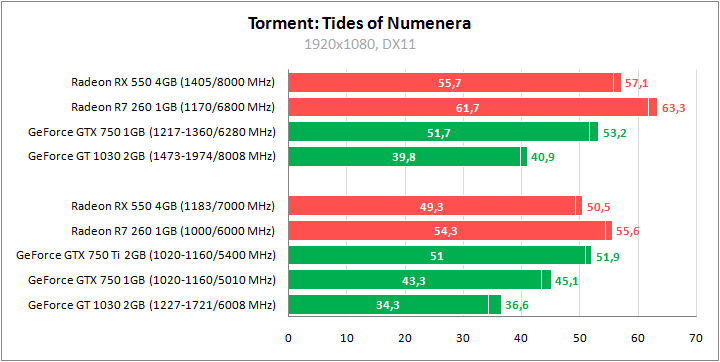
The highest rates are in the Radeon R7 260. It is 10% weaker than the Radeon RX 550, while the gap from the GeForce GTX 750 Ti is only 3%. The GeForce GT 1030 copes with this isometric game worst of all, demonstrating 36 fps, which is not enough for a comfortable gaming process. Overclocking speeds up the Radeon RX 550 by 13%. GeForce GT 1030 gains up to 16% gain from higher frequencies.
Warhammer 40000: Dawn of War III

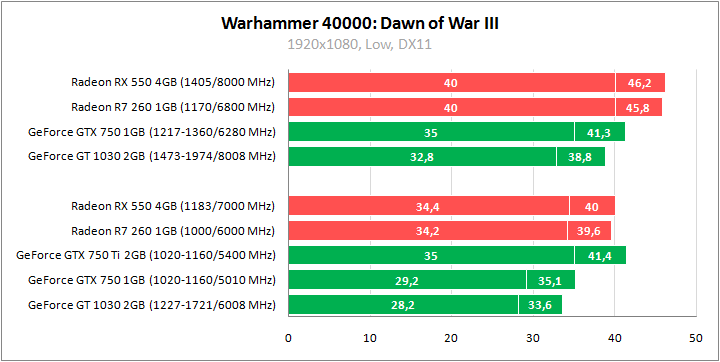
Once again, AMD has excellent results. Radeon RX 550 and Radeon R7 260 show identical results in nominal and overclocked. At the initial frequencies, they are minimally inferior to the GeForce GTX 750 Ti, confidently outperforming low-end NVIDIA solutions. The GeForce GT 1030 loses 19-22% to the newcomer AMD, but when the frequencies are increased it comes close to its performance level.
Watch Dogs 2

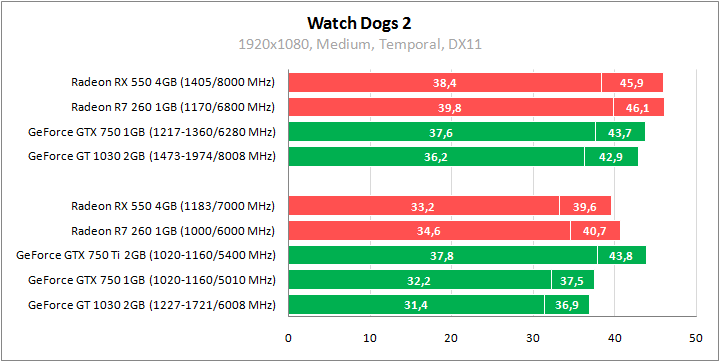
Radeon RX 550 outperforms GeForce GT 1030 by 7% in Watch Dogs 2, yielding to Radeon R7 260 by about 3-4%. In overclocking, the newcomer AMD easily overtakes the GeForce GTX 750 Ti at standard frequencies. The forced GeForce GT 1030 just as confidently bypasses the Radeon RX 550 in the nominal value.
War Thunder
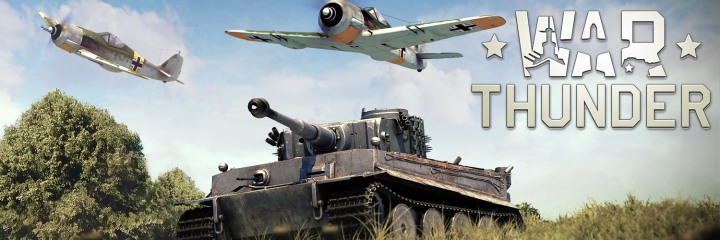
At the end of the game tests, let’s take a look at the results in the popular tank MMOs.
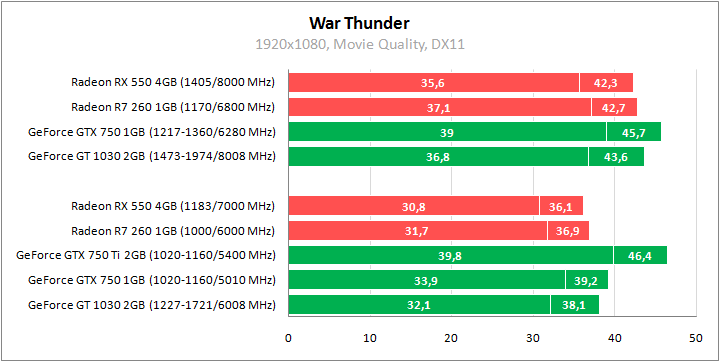
The best results are demonstrated by NVIDIA solutions. GeForce GT 1030 is 5% faster than Radeon RX 550 and 1–3% better than Radeon R7 260. In overclocking, the GeForce GT 1030 retains a slight advantage over Radeon RX 550, higher performance is in GeForce GTX 750.
World of Tanks

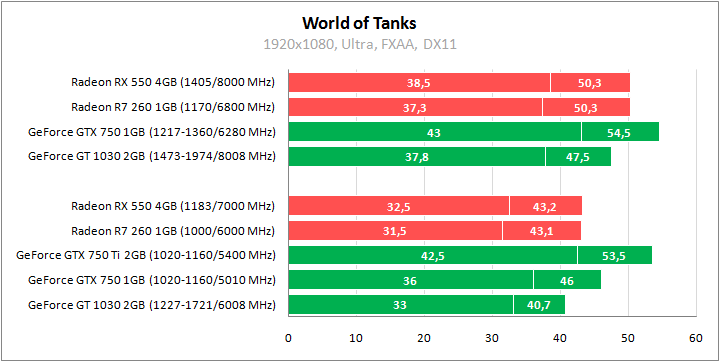
In this game, the Radeon RX 550 snatches the victory over the GeForce GT 1030, but with a slight margin of 3–6%. An even more modest advantage over the Radeon R7 260. The gap between the Radeon RX 550 and the GeForce GTX 750 is 6-11%. Overclocking speeds up newcomer AMD by 16-18%. The GeForce GT 1030 gains a 14-17% gain from higher frequencies.
Read about the performance of more powerful video cards in War Thunder and World of Tanks in our special testing.
3DMark Fire Strike

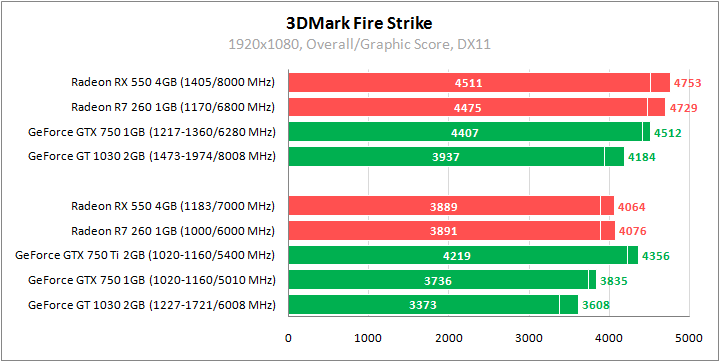
Identical results for Radeon RX 550 and Radeon R7 260 in nominal and overclocked. At standard frequencies, the Radeon RX 550 is 13% faster than the GeForce GT 1030 and 6% better than the GeForce GTX 750. In overclocking, the GeForce GTX 750 Ti with standard frequencies is confidently outperformed.
As a supplement, we present a comparison of the results of ultra-budget video cards with representatives of the higher price category from our recent testing. This will allow you to compare the Radeon RX 550 with the Radeon RX 560 or GeForce GTX 1050.
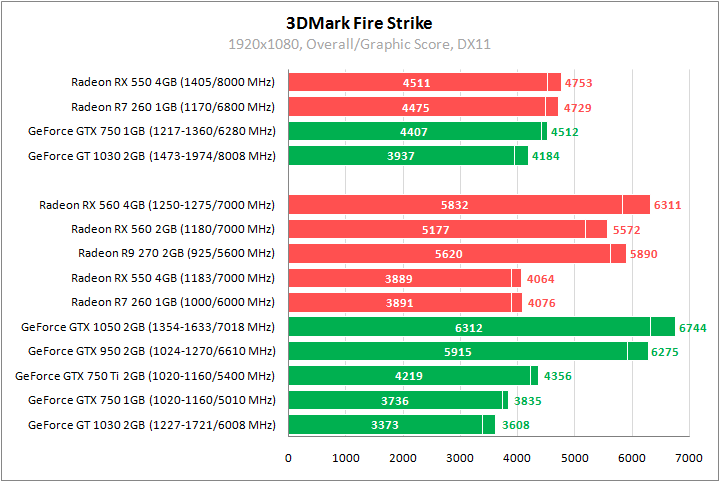
Radeon RX 550 is 37% weaker than the simplest economic version of the Radeon RX 560, and the difference with the full version of the Radeon RX 560 is at the level of 55%
3DMark Time Spy

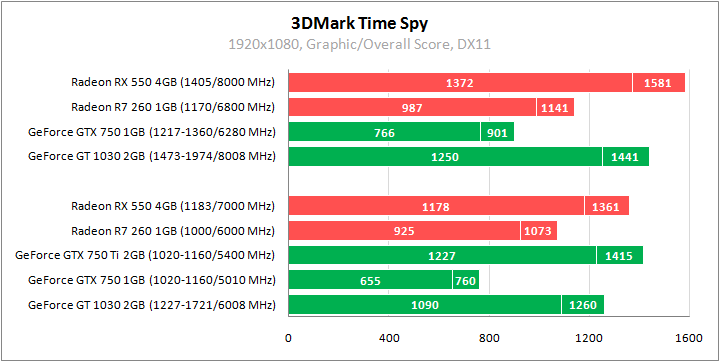
Unusual alignment of forces in the new benchmark. There is a colossal gap between the GeForce GTX 750 Ti and the GeForce GTX 750, which is clearly due to the different memory sizes. There is no such striking gap between the Radeon RX 550 and the Radeon R7 260, but the advantage is clearly on the side of the newcomer. GeForce GT 1030 is inferior to Radeon RX 550 by up to 8%.
And again we will present on a separate graph the results of the reviewed video cards and the participants in the big test of the Radeon RX 560.
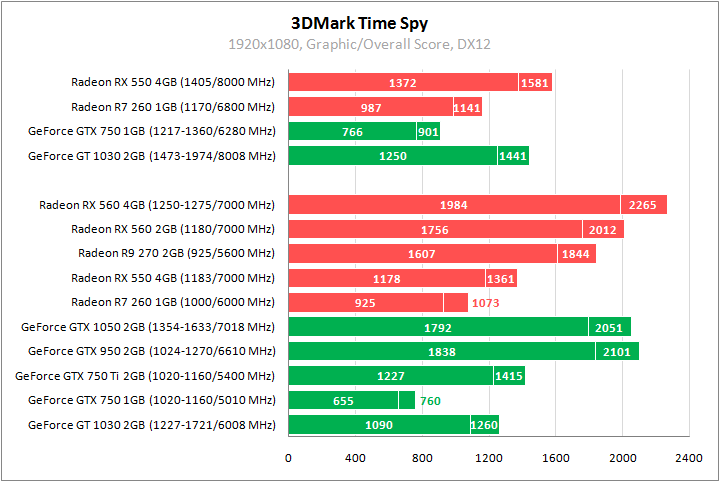
Here the difference between the Radeon RX 550 and the older version of the Radeon RX 560 reaches 68%.
Energy consumption
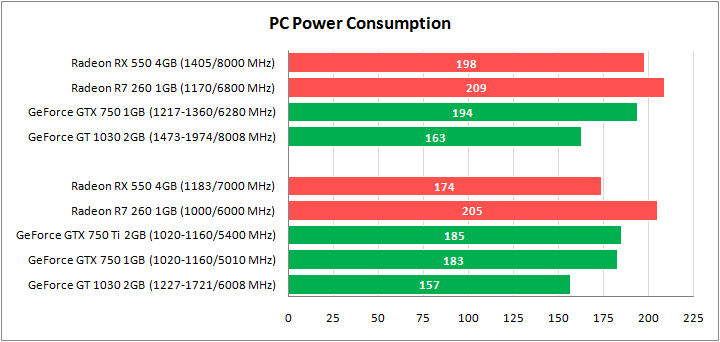
A system with a Radeon RX 550 is more economical than a configuration with a GeForce GTX 750 or GeForce GTX 750 Ti. Overclocking seriously increases the level of power consumption of the Radeon RX 550; the final difference with the accelerated video adapter GeForce GTX 750 is small. The most economical solution is the GeForce GT 1030, which is quite consistent with the declared characteristics.
conclusions
According to the test results, it can be seen that the performance of the Radeon RX 550 is as close as possible to that of the Radeon R7 260. In some games we see even a good advantage, but this is due to the large amount of memory (Battlefield 1, DiRT 4, GTA 5). Compared to the old generation NVIDIA, the new Radeon RX 550 occupies a middle position between the GeForce GTX 750 and the GeForce GTX 750 Ti, and overclocking makes it easy to overtake the older rival. At the same time, the Radeon RX 550 has the lowest power consumption. But with heating and noise, everything is not so successful, the characteristics depend on the cooling system for each specific model. The Polaris chips are quite hot, and the high revs of the ASUS RX550-4G hint to us that the operating temperatures of a budget GPU can be high in quiet mode. If total comfort is important to you, then it is better to look for reviews before choosing a specific Radeon RX 550 model. The advantages of this card include the presence of all current video interfaces, including DisplayPort. The GeForce GT 1030 is equipped with DVI-D and HDMI only.
The GeForce GT 1030 is weaker in most games, although in some applications the video adapter is equal to the Radeon RX 550. Overclocking allows the competitor AMD to catch up. At the same time, NVIDIA’s version is cheaper, which is quite consistent with its capabilities. Among the advantages are the lowest power consumption and very low heating of the chip, due to which there are versions with passive cooling.
The reviewed video card ASUS Radeon RX 550 4G (RX550-4G) is allocated with an increased amount of memory. For products of this level, 2 GB is the optimal solution, but 4 GB can also be used in some demanding games. In nominal terms, the video card is cold, but noisy. A fixed fan speed does not allow manual selection of the optimum setting. Good overclocking potential allows for significant performance gains.
It is pleasant to note the general growth of the gaming potential and capabilities of the cheapest new generation video cards. They compete confidently with older models that started from a higher price point in the past. Radeon RX 550 and GeForce GT 1030 allow you to play modern games at low to medium graphics settings, and in some cases they can provide higher picture quality.




